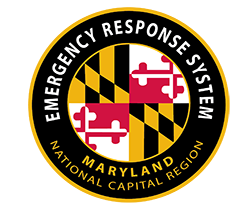Interdisciplinary coordination is paramount to position a jurisdiction to effectively mitigate, plan, respond, and recover from various emergencies. As a pivotal cog in this process, the Montgomery County Office of Emergency Management and Homeland Security (OEMHS) has organized a series of exercises to evaluate Montgomery County agencies and departments’ ability to cohesively fulfill their responsibilities during disasters. To support this initiative, the Maryland-National Capital Region Emergency Response System (MDERS) has assisted OEMHS in the creation and implementation of this exercise series. The proactive steps from Montgomery County leadership and OEMHS, with the support from MDERS, will enhance the jurisdiction’s ability to collectively manage emergencies.
To prepare for emergencies, it is critical for localities to continuously evaluate their ability to effectuate the identified requirements in their plans, policies, and procedures. As the complexity of a disaster expands, it requires more departments to assume an active role in response efforts. The convergence of these distinct departments demands a high-level of coordination to identify individual and shared responsibilities in disaster situations. OEMHS convened Montgomery County’s Emergency Management Group (EMG) to examine their plans, identify corrective actions, and clearly delineate responsibilities during emergencies.
To begin the exercise series, representatives from OEMHS hosted a summit in August that provided general information about emergency management to department representatives. The summit transitioned into a workshop setting with departments outlining their expected actions during different emergency scenarios. This discussion provided a foundation for departments to understand the unique roles their peers have within the County.
The next phase of the exercise series was a Senior Policy Group (SPG) workshop. The SPG is responsible for macrolevel decisions that deal with life safety, government operations, funding, and legal issues. This group is comprised of agency leadership from the following departments:
- Office of the County Executive
- Office of the County Attorney
- Office of Emergency Management and Homeland Security
- Department of Environmental Protection
- Fire and Rescue Service
- Department of General Services
- Department of Health and Human Services
- Department of Permitting Services
- Department of Police
- Office of Public Information
- Department of Technology and Enterprise Business Solutions
- Department of Transportation
The workshop engaged representatives to progressively navigate the County’s response effort to a tornado that caused tremendous devastation. The scenario necessitated a large-scale response with the SPG collectively discussing logistics and supply chain management, operational communications, operational coordination, and public information and warning. The workshop was well received by all participants as the SPG continues to evolve and adapt to the threats Montgomery County may encounter.
MDERS staff were vital in the creation and execution of the SPG workshop. Deputy Director Hannah Thomas and Emergency Response Specialist Katie Weber jointly created the scenario with OEMHS Emergency Management Specialist Zachary Estess. Additionally, Deputy Director Thomas served as a co-facilitator during the workshop, Specialist Weber served as the logistics lead for the workshop, and Senior Emergency Response Specialist Peter McCullough served as the evaluation lead.
The exercise series will continue to test the response efforts of the Montgomery County EMG through additional discussion and operations-based exercises. MDERS will continue to collaborate with OEMHS throughout this process to enhance the cohesive emergency preparedness of Montgomery County.



 The workshop engaged representatives to progressively navigate the County’s response effort to a tornado that caused tremendous devastation. The scenario necessitated a large-scale response with the SPG collectively discussing logistics and supply chain management, operational communications, operational coordination, and public information and warning. The workshop was well received by all participants as the SPG continues to evolve and adapt to the threats Montgomery County may encounter.
The workshop engaged representatives to progressively navigate the County’s response effort to a tornado that caused tremendous devastation. The scenario necessitated a large-scale response with the SPG collectively discussing logistics and supply chain management, operational communications, operational coordination, and public information and warning. The workshop was well received by all participants as the SPG continues to evolve and adapt to the threats Montgomery County may encounter.

 Testimonials from the Field: Officers who have participated in this training reported an increased confidence in their ability to execute the techniques and skills learned. Lieutenant Daniel Siculietano from PGPD SOD commented, “This training is invaluable and provides an outstanding asset to the police department.” Five MDERS staff members had the opportunity to observe the training this spring. Emergency Response Specialist Elizabeth Adams, one of those staff members, remarked, “Witnessing aerial platform training firsthand was incredibly enlightening. The dedication and skill demonstrated by the officers from PGPD SOD was truly impressive. This training is crucial to ensuring that personnel are consistently prepared to respond to critical incidents.”
Testimonials from the Field: Officers who have participated in this training reported an increased confidence in their ability to execute the techniques and skills learned. Lieutenant Daniel Siculietano from PGPD SOD commented, “This training is invaluable and provides an outstanding asset to the police department.” Five MDERS staff members had the opportunity to observe the training this spring. Emergency Response Specialist Elizabeth Adams, one of those staff members, remarked, “Witnessing aerial platform training firsthand was incredibly enlightening. The dedication and skill demonstrated by the officers from PGPD SOD was truly impressive. This training is crucial to ensuring that personnel are consistently prepared to respond to critical incidents.”